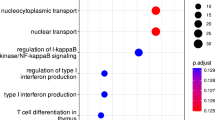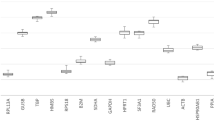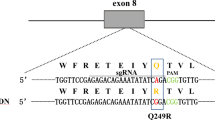Abstract
Gene targeting is accomplished using embryonic stem cells in the mouse but has been successful, only using primary somatic cells followed by embryonic cloning, in other species. Gene targeting in somatic cells versus embryonic stem cells is a challenge; consequently, there are few reported successes and none include the targeting of transcriptionally silent genes or double targeting to produce homozygotes. Here, we report a sequential gene targeting system for primary fibroblast cells that we used to knock out both alleles of a silent gene, the bovine gene encoding immunoglobulin-μ (IGHM), and produce both heterozygous and homozygous knockout calves. We also carried out sequential knockout targeting of both alleles of a gene that is active in fibroblasts, encoding the bovine prion protein (PRNP), in the same genetic line to produce doubly homozygous knockout fetuses. The sequential gene targeting system we used alleviates the need for germline transmission for complex genetic modifications and should be broadly applicable to gene functional analysis and to biomedical and agricultural applications.
This is a preview of subscription content, access via your institution
Access options
Subscribe to this journal
Receive 12 print issues and online access
$259.00 per year
only $21.58 per issue
Buy this article
- Purchase on SpringerLink
- Instant access to full article PDF
Prices may be subject to local taxes which are calculated during checkout




Similar content being viewed by others
References
Hooper, M., Hardy, K., Handyside, A., Hunter, S. & Monk, M. HPRT-deficient (Lesch-Nyhan) mouse embryos derived from germline colonization by cultured cells. Nature 326, 292–295 (1987).
Capecchi, M.R. Altering the genome by homologous recombination. Science 244, 1288–1292 (1989).
Thompson, S., Clarke, A.R., Pow, A.M., Hooper, M.L. & Melton, D.W. Germ line transmission and expression of corrected HPRT gene produced by gene targeting in embryonic stem cells. Cell 56, 313–321 (1989).
McCreath, K.J. et al. Production of gene-targeted sheep by nuclear transfer from cultured somatic cells. Nature 405, 1066–1069 (2000).
Denning, C. et al. Deletion of the α-(1,3)galactosyl transferase (GGTA1) gene and the prion protein (PrP) gene in sheep. Nat. Biotechnol. 19, 559–562 (2001).
Lai, L. et al. Production of α-1,3-galactosyltransferase knockout pigs by nuclear transfer cloning. Science 295, 1089–1092 (2002).
Yifan, D. et al. Targeted disruption of the α-1,3-galactosyltransferase gene in cloned pigs. Nat. Biotechnol. 20, 251–255 (2002).
Thomson, A.J., Marques, M.M. & McWhir, J. Gene targeting in livestock. Reprod. Suppl. 61, 495–508 (2003).
Denning, C. & Priddle, H. New frontiers in gene targeting and cloning: success, application and challenges in domestic animals and human embryonic stem cells. Reproduction. 126, 1–11 (2003).
Piedrahita, J.A. Targeted modification of the domestic animal genome. Theriogenology 53, 105–116 (2000).
Sedivy, J.M. & Dutriaux, A. Gene targeting and somatic cell genetics – a rebirth or a coming of age? Trends Genet. 15, 88–90 (1999).
Wang, B. & Zhou, J. Specific genetic modifications of domestic animals by gene targeting and animal cloning. Reprod. Biol. Endocrinol. 1, 103–111 (2003).
Phelps, C.J. et al. Production of alpha 1,3-galactosyltransferase-deficient pigs. Science 299, 411–414 (2003).
Sharma, A. et al. Pig cells that lack the gene for alpha1-3 galactosyltransferase express low levels of the gal antigen. Transplantation 75, 430 (2003).
Yagi, T. et al. Homologous recombination at c-fyn locus of mouse embryonic stem cells with use of diphtheria toxin A-fragment gene in negative selection. Proc. Natl. Acad. Sci. USA 87, 9918–9922 (1990).
Lakso, M. et al. Targeted oncogene activation by site-specific recombination in transgenic mice. Proc. Natl. Acad. Sci. USA 89, 6232–6236 (1992).
Valenzuela, D.M. et al. High-throughput engineering of the mouse genome coupled with high-resolution expression analysis. Nat. Biotechnol. 21, 652–659 (2003).
Abuin, A. & Bradley, A. Recycling selectable markers in mouse embryonic stem cells. Mol. Cell. Biol. 16, 1851–1856 (1996).
Mansour, S.L., Thomas, K.R. & Capecchi, M.R. Disruption of the proto-oncogene int-2 in mouse embryo-derived stem cells: a general strategy for targeting mutations to non-selectable genes. Nature 336, 348–352 (1988).
Sullivan, E.J. et al. Cloned calves from chromatin remodeled in vitro. Biol. Reprod. 70, 146–153 (2004).
Wilmut, I., Schnieke, A.E., McWhir, J., Kind, A.J. & Campbell, K.H.S. Viable offspring derived from fetal and adult mammalian cells. Nature 385, 810–813 (1997).
Zhou, Q. et al. Generation of fertile cloned rats by regulating oocyte activation. Science 302, 1179 (2003).
Chesne, P. et al. Cloned rabbits produced by nuclear transfer from adult somatic cells. Nat. Biotechnol. 20, 366–369 (2002).
Cibelli, J.B. et al. Cloned transgenic calves produced from nonquiescent fetal fibroblasts. Science 280, 1256–1258 (1998).
Polejaeva, I.A. et al. Cloned pigs produced by nuclear transfer from adult somatic cells. Nature 407, 86–90 (2000).
Kuroiwa, Y. et al. Cloned transchromosomic calves producing human immunoglobulin. Nat Biotechnol. 20, 889–894 (2002).
Acknowledgements
We thank J. Pommer, J. Koster, J. Molina and D. Faber for their assistance in embryo transfer, fetal recovery, calf delivery and sample collection and M. Nichols, J. Griffin, M. Bien, T. King, M. Ahlers, R. Paulson, S. Viet and C. Voss for their assistance in gene targeting and embryo cloning.
Author information
Authors and Affiliations
Corresponding authors
Ethics declarations
Competing interests
Y.K., M.K. and I.I. are employed by Kirin Brewery, which may gain or lose financially owing to publication of this paper. P.K., H.M., J.S., E.J.S. and J.M.R. are employed by Hematech, which may gain or lose financially owing to publication of this article. J.M.R. has a substantial financial interest in Hematech.
Rights and permissions
About this article
Cite this article
Kuroiwa, Y., Kasinathan, P., Matsushita, H. et al. Sequential targeting of the genes encoding immunoglobulin-μ and prion protein in cattle. Nat Genet 36, 775–780 (2004). https://doi.org/10.1038/ng1373
Received:
Accepted:
Published:
Issue date:
DOI: https://doi.org/10.1038/ng1373
This article is cited by
-
Versatile generation of precise gene edits in bovines using SEGCPN
BMC Biology (2023)
-
Proposed U.S. regulation of gene-edited food animals is not fit for purpose
npj Science of Food (2019)
-
Combinations of chromosome transfer and genome editing for the development of cell/animal models of human disease and humanized animal models
Journal of Human Genetics (2018)



